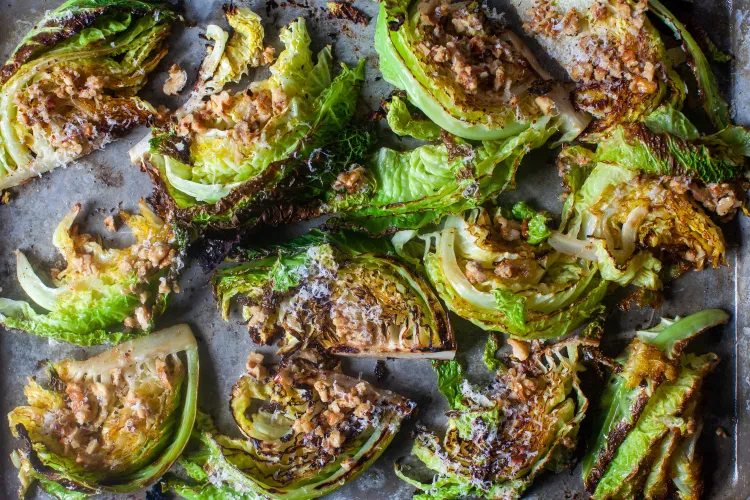Savoy Cabbage: The Underrated Superstar of the Cruciferous Family (June 30, 2024)

While its green cousin, green cabbage, hogs the spotlight, savoy cabbage deserves a standing ovation in the world of vegetables. Don’t be fooled by its crinkled, bumpy exterior. Savoy cabbage is a nutritional powerhouse with a surprisingly delicate flavor and a delightful textural contrast.
This article dives deep into the world of savoy cabbage, exploring its fascinating history, unique characteristics, and delicious culinary applications.
A History Steeped in Tradition
Savoy cabbage boasts a rich heritage. Believed to have originated in the 16th century, it gets its name from the Savoy region of France, where it was first cultivated. This leafy green quickly gained popularity throughout Europe, prized for its versatility and hardiness.
Unveiling the Savoy Cabbage: A Look at its Quirks
What truly sets savoy cabbage apart is its appearance. Unlike the smooth, tightly wound leaves of green cabbage, savoy cabbage features beautiful, crinkled leaves. These emerald green folds with a hint of pale yellow inside create a stunning visual texture.
But beauty isn’t just skin deep for savoy cabbage. The crinkled leaves indicate a looser head, translating to a milder, sweeter flavor compared to green cabbage. The leaves themselves have a wonderful textural range. The outer leaves are tougher, perfect for braising or stewing, while the inner leaves are more delicate, ideal for salads, slaws, or quick stir-fries.
Savoy Cabbage: A Nutritional Powerhouse
Savoy cabbage isn’t just delicious; it’s packed with nutrients! It’s an excellent source of vitamin C, essential for a healthy immune system and collagen production. It’s also rich in vitamin K, which plays a crucial role in blood clotting and bone health.
But that’s not all. Savoy cabbage is a good source of fiber, aiding digestion and promoting gut health. It also boasts essential minerals like potassium, important for regulating blood pressure, and manganese, which helps the body process enzymes.
Savoring the Flavor: How to Cook with Savoy Cabbage
Savoy cabbage’s versatility shines in the kitchen. Its delicate sweetness makes it perfect for both raw and cooked applications. Here are some ways to explore the culinary possibilities of savoy cabbage:
- Salads and Slaws: Thinly sliced savoy cabbage adds a delightful crunch and a touch of sweetness to salads. You can use both the inner and outer leaves, creating a delightful textural contrast. Experiment with different dressings and mix-ins for a refreshing and healthy side dish.
- Soups and Stews: The outer leaves of savoy cabbage hold their form well in soups and stews. Their mild flavor complements various broths and complements other vegetables.
- Braising: This slow-cooking technique brings out the natural sweetness of savoy cabbage. Braised savoy cabbage pairs beautifully with meats, sausages, or even seafood.
- Stir-frying: The inner leaves of savoy cabbage cook quickly, making them ideal for stir-fries. Their subtle sweetness complements various sauces and proteins.
Selecting and Storing Savoy Cabbage: Picking the Perfect Head
When choosing savoy cabbage, look for heads that feel firm and heavy for their size. The leaves should be crisp and brightly colored, with minimal wrinkling or yellowing. Avoid heads with soft spots or blemishes.
Savoy cabbage can be stored in the crisper drawer of your refrigerator for up to a week. To maximize freshness, remove any loose outer leaves and wrap the head loosely in plastic.
Savoy Cabbage: Beyond the Plate
The benefits of savoy cabbage extend beyond the kitchen. Studies suggest that savoy cabbage may help with iron absorption. Its unique ability to take up iron, even in the absence of sunlight, makes it a potentially valuable dietary source for those prone to iron deficiency.
Conclusion: Savoy Cabbage – A Delicious and Nutritious Choice
Savoy cabbage is a delightful addition to any kitchen. With its unique appearance, mild flavor, and impressive nutritional profile, it deserves a starring role on your plate. So, next time you’re at the grocery store, don’t overlook the savoy cabbage. Embrace its crinkled beauty and discover a world of culinary possibilities!
Savoy Cabbage Takes Center Stage: Delicious and Easy Recipes for Every Meal

Savoy cabbage, with its crinkly green leaves and milder flavor compared to its green cabbage cousin, is a versatile vegetable that deserves a place on your dinner table. Packed with vitamins and nutrients, savoy cabbage can be enjoyed in a variety of ways, from simple side dishes to hearty main courses.
This article explores the exciting world of savoy cabbage recipes, offering a range of options for every skill level and taste preference. Whether you’re a seasoned cook or just starting out in the kitchen, you’ll find something delicious and easy to prepare.
Savoring the Basics: Simple Sides and Salads
For those new to savoy cabbage, or simply looking for a quick and healthy side dish, there are several basic options that showcase the vegetable’s natural flavor.
-
Buttery Bliss: Perhaps the easiest way to enjoy savoy cabbage is by braising it in butter. Simply slice the cabbage thinly, melt butter in a pan, and cook the cabbage until tender. Season with salt and pepper to taste. This recipe is a great introduction to savoy cabbage and pairs well with roasted chicken or fish.
-
Sautéed Sensation: Sautéing adds another layer of flavor to savoy cabbage. Heat olive oil in a pan, add chopped onions or garlic, and cook until fragrant. Add sliced cabbage and cook until softened. Season with your favorite herbs, such as thyme or rosemary, for an extra kick. A splash of lemon juice brightens up the dish, making it a perfect accompaniment to grilled meats.
-
Slaw Surprise: Savoy cabbage adds a delightful texture to coleslaw. Thinly shred the cabbage and toss it with a simple vinaigrette made from olive oil, vinegar, sugar, and salt. Add chopped carrots, apples, or raisins for extra sweetness and crunch. This refreshing slaw is a perfect side dish for barbecues or picnics.
Comforting Classics: Warm and Savory Dishes
Savoy cabbage thrives in warm, comforting dishes, adding a satisfying heartiness to stews, soups, and casseroles.
-
Creamy Cabbage and Potato Delight: This one-pot wonder combines the creaminess of potatoes with the earthy taste of savoy cabbage. Parboil cubed potatoes, then cook sliced cabbage in butter or olive oil. Combine the vegetables in a pot with chicken broth and cream, and simmer until everything is tender. Season with salt, pepper, and a touch of nutmeg for a heartwarming meal.
-
Hearty Sausage and Cabbage Stew: Sausages and savoy cabbage are a match made in heaven. Brown sausages in a pot, then add chopped onions and garlic. Sauté chopped cabbage until softened. Pour in diced tomatoes, chicken broth, and your favorite herbs. Simmer until the stew thickens and the cabbage is tender. Serve with crusty bread for a satisfying dinner.
-
Cheesy Cabbage Casserole: This casserole is a great way to use up leftover cooked cabbage. In a baking dish, layer cooked cabbage with cooked rice or quinoa. Top with a mixture of shredded cheese, breadcrumbs, and melted butter. Bake until golden brown and bubbly. This casserole is a vegetarian option that can easily be made vegan by using plant-based cheese.
Global Adventures: Exploring International Flavors
Savoy cabbage is a popular ingredient in many cultures around the world. Here are a couple of international recipes to broaden your culinary horizons.
-
German Sauerkraut: Sauerkraut is a fermented cabbage dish that is a staple in German cuisine. Savoy cabbage is shredded and brined in a salty solution, allowing beneficial bacteria to grow and create a tangy flavor. Sauerkraut can be enjoyed on its own or added to sausages, sandwiches, and stews.
-
Irish Colcannon: This traditional Irish dish features mashed potatoes combined with chopped kale or savoy cabbage, butter, and milk. Colcannon is a hearty and flavorful side dish that is often served with corned beef or roasted lamb.
-
Korean Kimchi: Kimchi is a spicy fermented cabbage dish that is a cornerstone of Korean cuisine. Savoy cabbage is salted, then flavored with Korean chili flakes, garlic, ginger, and other seasonings. The cabbage ferments for several days, developing a complex and spicy flavor profile. Kimchi is a delicious accompaniment to Korean barbecue or any other savory meal.
These are just a few examples of the many ways to enjoy savoy cabbage. With its versatility and affordability, savoy cabbage is a welcome addition to any kitchen. So next time you’re at the grocery store, don’t hesitate to pick up a head of savoy cabbage and explore the world of delicious recipes that await!